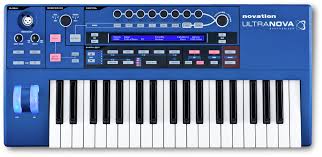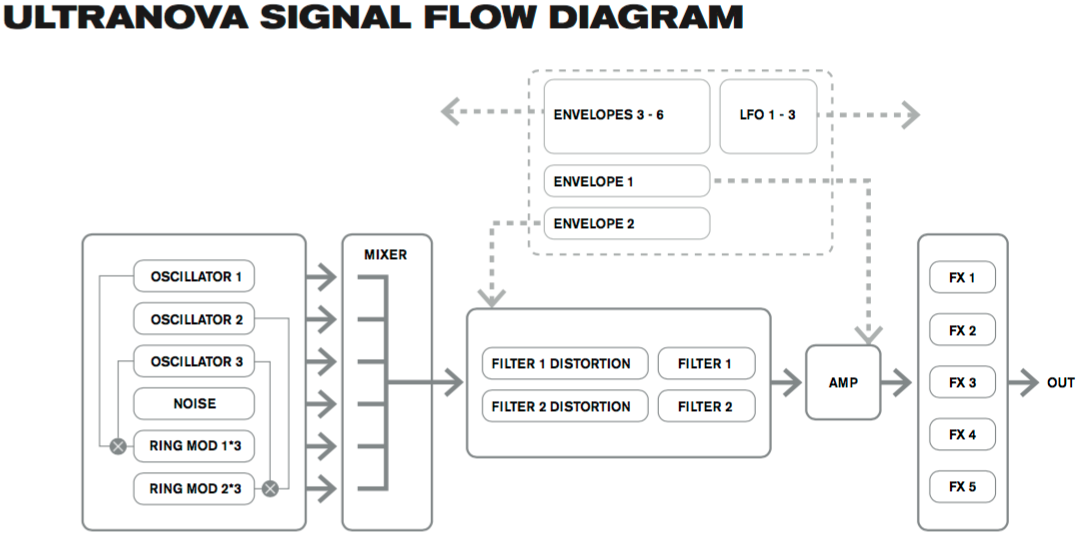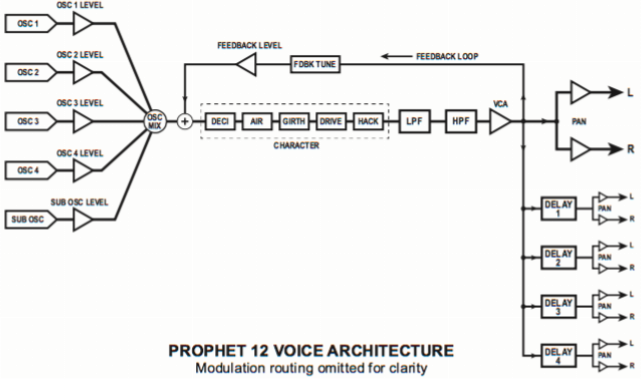The Prophet 12 vs the Ultranova
At first glance these two synthesizers may not seem to share much in common… one being a budget synthesizer retailing for only $599, the other being a boutique flagship synth coming in at $1799 (for the desktop module).
But what these synths do have in common is actually rather intriguing. Both feature a complex set of oscillators capable of sonic territory that can run from smooth to gritty, from basic to intricate, and both can modulate their oscillators in interesting ways.
Both of these synths have incredible amounts of modulation sources and destinations which equate to having a truly powerful sound design engine to work with. Both are known as modulation powerhouses.
The build quality of these two surely take very different approaches but for now we will try to focus more on sound possibilities and how these two work in a sonic creation stand point. Of course the Metal and wood of the DSI product feels solid and clearly more expensive than the plastic of the Novation but the UN by no means has a cheap feeling key bed (in fact its one of my favorites) and features like touch capacitive knobs and high resolution knobs are a step toward a more professional product.
so lets get right down to some of the nerdy specs that a shoot out is good for. This video below is just an a broad view of what is covered in the article. some audio and visual examples essentially. Please enjoy!
First up, Lets talk
OSCILLATORS
Now both of these units use digital oscillators the difference really comes down to the waveforms and how they are utilized.
The Prophet 12 Has 4 oscillators that use Sharc DSP chips to produce your typical waveforms of square, saw , sine, triangle as you would expect but also creates 12 digital shapes and 3 noise types (white, pink, violet) Each oscillator has a wave shape control that allows you to blend the primary waveform between two other secondary waveforms allowing the 12 digital waves to become far more versatile. The oscillators can be cross modulated with FM (linear and exponential) and AM synthesis and can also be Hard sync’d. Additionally the waveforms then pass through a “Character” section in which you can apply special EQ curves for adding low tones, higher tones, digital saturation, bit crushing and sample rate reduction all before being sent out into the filters. there is also an option for “slop” per oscillator to simulate the tracking irregularities of an analog oscillator. Glide per oscillator is also available as well.
On the Ultranova there are 3 oscillators, 2 ring modulators, and 1 noise generator per voice. square, sine, tri, saw, pulse, 9 saw/pulse combinations in addition to the traditional waveforms there are 20 digital waveforms and 36 wavetables. The wavetables can have the index modulated to create an even deeper pallet of sounds. Additionally the waveforms can use a virtual sync which will provide additional harmonics by syncing the oscillators to a virtual oscillator. Sync can be hard or soft with a varying degree. You can freely adjust oscillator phase, drift and vibrato. drift is global not per oscillator. There is also a detune and detune density control to create those super saw type waveforms.
Now just on the outside looking in you may view the Prophet 12 as being underpowered in this regard. DSI claims the waveforms they have selected were carefully chosen to provide appropriate sonic diversity. A nice touch with these waveforms is that they are named in a fairly descriptive nature which aids in quickly selecting a waveform that suits the sound you are going for. Also the fact the Pro12 can arrange the oscillators in any manner of FM combinations provides a 4 operator FM synth (or you can split it up so that you have any number less operators and use the left over oscillators in other methods). The Ultranova on the other hand has more waveforms and includes traditional wavetables. These wave tables are essentially 9 waveforms that can be swept between. The Ultranova also gives you control of just how smooth that sweep is. all of this adds up to some pretty deep oscillator synthesis. In addition to the wavetables the 20 digital waveforms cover the sort of sonic spectrum one might derive from FM synthesis or divide down organ style sounds and flute like tones. You can also use an external input as a waveform.
One area of note on the Prophet 12 however is the odd output shapes of the waveforms. What I mean by this is the shapes all have an odd character about them, the shapes are not “true”. Take a look at this “Triangle” waveform from the Prophet 12
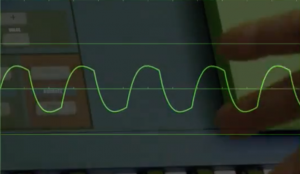
Clearly that is not how a triangle wave in most synthesizers would appear on a scope. Interestingly when I asked DSI about this issue, they informed me that if you were to tap off of the DSP chip that it would be a triangle…. so where is it being distorted? Additionally I have looked at a Pro2 which has the same oscillator creation yet doesn’t have this characteristic, so something was changed… its not a problem but its an aspect that one may want to be aware of when plunking down big bucks on a synthesizer.
So who wins in this category? the UN or the Pro12? we thats a mighty tough question considering the Prophet can perform actual FM synthesis while the UN is left imitating those sounds with waveforms and indexing. The Un has far more waveforms and deep control over how the waveform blends and moves. it also has hard and soft sync as well as virtual sync. …. I feel I have to give a slight edge here to the Ultranova…. those additional waveforms are mighty hard to beat along with all the modulation opportunities.
Filter Section.
The filter section is an area that is for the Pro12 quite frankly a big selling point. Why you might ask? well be cause the Pro12 utilizes real analog filters as opposed the Ultranova remaining with digital filters at this point.
So whats the big deal about analog filters over digital filters? Why are analog filters so sought after? Well for one the sound. there is no 1’s and 0’s no stepping just smooth silky filter action. secondly there is the resonance. Analog is known for its wild and interesting resonance that is just so hard to emulate.
But what are the draw backs to an analog filter? Well this is up for some debate but analog filters can also be a tad limiting. for one you are stuck with the structure of the filter provided in the circuitry. They can be expensive to implement, and you still have to find a way to control them (often through digital means).
So lets examine the Pro12 Filter section first. The Pro12 uses Curtis filter chips in both 2 pole and 4 pole modes as well as a refined version of the Tempest drum machines Highpass filter per voice. The 4 pole filter will self resonate and create a perfect sine wave as well. The filter also has its own dedicated envelope as well as can have its resonance amount and its filter cut off as modulation destinations.
It is controlled by dedicated knob controls for low pass cut off and resonance and high pass cut off and resonance
Over on the Ultranova filtering gets a bit more complex than the 3 filtering methods of the Pro12.
tipping the scales with 2 filters per voice and a whopping 14 filter variations the Ultranova gives a wide variety of solutions when it comes to sculpting harmonics. The filter types in the UN are Low pass : 6db, 12db, 18db, 24db Bandpass: 6:6, 6:12, 12:6, 6:18, 18:6, 12:12 Highpass: 6db, 12db, 18db, 24db. UltraNova provides five possible combinations of the two filter blocks, as well as bypass. Single mode uses Filter 1 only, the other modes interconnect the two filter sections in various ways.
But the UN filters are digital and digital filters lose to analog every time right? well obviously this is subjective in debate however I will say a few points here.
- the Pro12 filters can be bubbly smooth when controlled by LFO’s and envelopes However the physical pot control of the filters are digital and not any smoother than most digital filters. What this results in is a filter that even though it is analog, it has stepping when swept by the knobs. I don’t believe this is a “tuning feature”. A real shame in my book and removes much of the advantage of having an analog filter to begin with. Alternatively The Ultranova has a dedicated filter knob that has double the resolution of typical control knobs resulting in extremely smooth filter sweeps with near zero audible stepping.
- Though the Prophet 12 uses analog filters, they are tame… very tame. This is of course a subjective note here but when I tend to reach for the analog filters in my modular synth or on my moog, I tend to reach for a filter with some bite. The Curtis filters of late model DSI gear just never really blew me away. When someone says analog filter it just isn’t the first one that jumps to my mind.
- Though the filters in the Ultranova are digital they are very versatile with many slopes and this makes it easy to dial in the slopes that you need. The other advantage here is that the routing of the filters are not set. The filter routing allows us to select parallel filtering, series , or single. add onto that the valve, diode, bit reduction and rate reduction for filter distortions and you have a huge range of character available in the filter section.
Now with that being said… just going off of the raw Low pass filter sound, which do you prefer… well I do find that the Ultranova has a slightly odd character to its filter sound. Its not the evil zipper sound that people grew to hate of digital filters of old, but there is something not quite normal in there. The best way I can describe it is a slightly hollow sound to the filter, Not the meaty fat sound of most analog filters and in that regard I think the Pro12 curtis filters do indeed have an edge. So what are we left with? A complex set of digital filters that exhibit a slightly odd hollow character about them with smooth response, or a rather polite yet full bodied filter that while smooth in body and tone, has a digital quality to its control. The Ultranova filters I find a bit better at making shiny timbers and raw complex modern tones While I find the Pro12 Filters a bit better at making smooth bass, calming pads and classic brass. Two very different approaches and I can’t say which is better. Just different.
Envelopes!
Both of these synths feature digital envelopes. The Ultranova out weights the Pro12 by 2 extra envelopes clocking in at 6 envelopes to 4. Both synths envelopes are quite snappy able to do both quick clicks and drum sounds as well as long evolving pad envelopes and gradually evolving sound scape. Both synths feature ADSR, delay, retrigger and looping. The Ultranova however goes a step further by allowing retrigger counts, and touch capacitve triggering. dedicated LED lights on the Ultranova show the rate at which the envelopes are progressing very nice for easily identifying the modulation slopes. The Prophet 12 however wins with its display actually showing you the slope of the envelopes in a graphic display as opposed to the Ultranova’s simple number read out.
LFO section
The LFO is one of the primary sources of modulation in any synth. The Ultranova clocks in with 3 LFO and the Pro12 outpaces it just a bit with 4 LFO’s But lets look at how deep these LFO’s are …
Controls for the Pro12 LFO’s are a fairly straight forward affair with slew and the standard “analog” style waveforms. you can also adjust phase and offset of course. The ultra nova has these same features but adds in a bunch of stepped and sequenced waveforms that include intervals and musical shifting.
Modulation
Modulation is where both of these synths really shine. The Prophet 12 has easily the most amount of any dave smith instrument and The Ultranova is no slouch in this regard either.
The Ultranova allows for 3 sources PER destination. These sources consist of 2 source parameters and one touch knob parameter and the sources are mixed with their final output being set by a positive or negative amount parameter. There are 20 of these slots and you can freely modulate sources and destinations with each other. 18 sources and 68 destinations freely assignable. 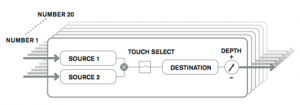
The Prophet 12 has eight fixed-source modulation paths and a 16
x 2 modulation matrix where the mod sources and destinations are completely user configurable. There are 26 modulation sources and 97 destinations. These modulation amounts like the Ultranova are bi-polar with positive and negative amounts.
while the layout of the two modulation sections of these synths are a bit different, they allow for much of the same modulation the Modulation matrix of the Prophet12 however has a few very nice tricks. The organization of being able to list modulations via source, destination, and slot is a very convenient way to scroll through and see what you have set up. Additionally the P12 gives you dedicated “assign mod source” and “assign mod destination” buttons as short cuts for setting up routing. very handy indeed.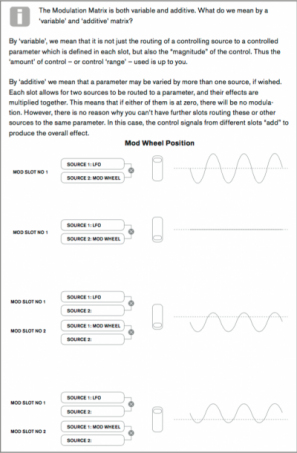
The layout of the ultranova allowing for 3 sources per slot however certainly adds a layer of flexibility that while technically can be achieved on the prophet 12, is a bit less fluid in setting up. Also these triple source modulations can actually save precious modulation slots so even though the number of modulation slots is less on the ultranova, the real world usage of them actually works out to be a tad more (think of it as 3×20= 60 modulation routings vs the 24 slots on the prophet 12). Adding to the confusion here, the FM and AM in the oscillator section of the Prophet12 isn’t actually counted in the modulation matrix but this gives you and additional 4 FM modulations and 4 AM modulations which would bring the total Prophet modulations up to 32.
These two are really modulation powerhouses and I give a ton of respect to both units in this regard. I find myself struggling to pick the winner on this subject as they handle modulations in different ways but at the end of the day, I have to give the edge to the Prophet 12 for the additional controllers, ability to use oscillators as both sources and destinations and ease of set up.
Effects section
This section is pretty straight forward as the only real FX in the Prophet 12 are the character section of the oscillators and the delay/feedback sections. The 4 delay lines in the Prophet 12 are very handy for creating everything from reverb like delays to slap backs and spacey time warps. The Feedback section can be tuned to offer a brilliantly dirty sound and really drive a lead sound into “cut through the mix” territory or let you channel your inner Hendrix with wild zoned out feedbacks.
The Ultranova takes the digital fx of its Novation product legacy and uses it to great effect (pardon the pun). The Ultranova gives you a hefty choice of fx ranging from Panning, EQ, Compression, Distortion, Delay,Chorus,Reverb,Gator. each of these FX can be loaded into one of 5 slots. these slots can be routed in 8 different combinations. Everything is controlled from a set of 4 screens in the FX dedicated section and easily altered with amounts, and settings on the screens. The different distortions really change the character of the synth and can allow you to drive the sound in different ways. Harsh digital clipping, emulated valve saturation, diode clipping etc allow you to pick and choose just what sort of temper the synth showcases. You also have access to a FX routing mixer so that you can adjust the pro and post FX levels so as to prevent internal clipping if desired.
User interface
Now before I dive into user interface I will say here I am using the P12 module, the difference from the desktop and the keyboard being dedicated controls as opposed to using the macro controls above the screen.
Both of these units feature a nice array of buttons that take you quickly to the section of the synthesizer you would like to edit. On the ultranova the bulk of controls are handled by a section of 8 encoder knobs above an LCD scribble strip and a dedicated high resolution “Touched/Filter” encoder. There is also control knobs for Browsing presets, and audio master and monitor pots. There are a total of 39 buttons on the front panel 7 of which are dedicated to the Automap VST controller software. While editing synth parameters you simply press the button that corresponds to the section (i.e. oscillator) from there you can scroll through menus using the back and next buttons or scroll through which oscillator , envelope, filter etc. you are editing using the up and down select buttons. A set of 3 flashing “Rate” LED’s give you visual feedback of your LFO’s. The dedicated touched/ Filter encoder is a really welcome addition. Unlike digital synths of old, the Ultranova provides very high resolution DSP control of each of its parameters. Gone are the days of zippering filters and bulky coarse controls. With the dedicated filter knob you can easily control minute details of your filter cutoff or resonance. The LCD screen is a bit of a let down however and easily my least favorite aspect of this synth. No control over contrast on the screen and a white on Blue LCD screen means that in some angles and lighting you will be squinting.
I love the scribble strip aspect for the knobs as it displays both what parameter the knob is controlling and the amount. Patch browsing is handled exceptionally well as you have a dedicated knob for patch browsing as well as the ability to sort by slot number, Bank, Category, and genre. This makes finding just the right type of sound very quick and easy. the LED lit mod wheels look and feel great and provide a very satisfying playing experience. The keys are some of the best synth action keys I have felt and rival or even surpass many of my more expensive synths. The Touch knobs for modulation are a bit of a gimmick to be honest but can be very fun for live playing and provide 8 quick to get to modulations. the TWEAK button turns those knobs into dedicated macros of which you can set up multiple routings to each knob, again very handy for live playing and tweaking.
The Prophet 12 Module is lacking in knobs however it has some slick aspects about it. with only 12 knobs on the front panel you can expect a little bit of menu diving however the layout is actually very intuitive. The Screen is a beautiful OLED and very readable with “soft knobs” above the screen to provide access to parameters. 4 dedicated filter pots are welcome for instant tweaking of the low pass and high pass filters cut off and resonance. these knobs unlike the the soft knobs are smooth potentiometers as opposed to the soft knobs notched encoders. The sad part of this however is the knob resolution doesn’t gain any benefit here and is still only 0-164. There is some sort of interpolation going on depending how fast you turn the knob but imho it feels a bit inconsistent and I am still able to get that stepped filter sound at high resonance which I am not a fan of. the Dedicated buttons for each section allow you to quickly jump between sections and which part of each section you would like to edit with the soft knobs. (i.e. oscillator 3 then jump to delay like 2) Holding down buttons in some instances will give you a group control of that section (i.e. hold down a delay button and you can then edit all delay times from one screen). There are 12 LED’s for showing you which voice is triggered at any given time. Unfortunately this is only a trigger indication and doesn’t show you voices that are still active while they decay. Dedicated buttons also exist for tap temp, Layering (A,B A+B split and stack) Global, Arp, and mod source/destination buttons. Browsing is handled by a bank select and program select set of encoders as well as a “compare” button, no menus for organizing patches like on the ultranova and the factory banks can not be erased.
The differences here are interesting as they are somewhat similar in the way you get around the synth, by pressing a button and then adjusting parameters using soft knobs while also having a dedicated filter knob. I think the two are on equal footing due to the gorgeous screen, dedicated filter and resonance pots, and the build quality of the knobs of the P12. Those features being answered back on the Ultranova with its far superior patch menu system however. The varying ways in which you can choose to control the ultranova also gives it an edge in terms of performance with the touch knobs and the tweak knobs.
Flexibility of the synth
Now we are really going to get into some of the heavier differences between these two synthesizers. The Prophet 12 is billed as a flagship digital analog hybrid while the Ultranova is billed as a digital synth with amazing live modulation flexibility. What about in the studio? which one really gives you the more usefulness? Here I can only give opinion as this is a very subjective matter, however I will qualify my pick using some specs. To the P12’s credit it is technically Bi-timbral where as the Ultranova is monotimbral. This gives it the edge if you need to use 2 synth parts from the unit at once. The Ultranova is an audio interface and a synthesizer and a VST controller. Now lets keep this strictly on the synth level of things here, so why do I mention those other features? Well the Ultranova has audio inputs… this allows us to use the synth as a sound mangler and a vocoder as well. Unfortunately even though the Pro12 has a gorgeous analog signal path to play with, there is no audio inputs. That means you can forget processing drums through your modulated filters and delays of the P12 while the Ultranova will tweak and freak all of your favorite sounds with ease. This aspect alone forces me to give the edge rather readily to the Ultranova
Overall tone of the synth
Okay so this is really what you bought the synth for right? Which one makes you drool more? which one makes you stop and noodle for hours… The answer however isn’t so easy. Both of these sound fantastic and both can really do a huge range of sounds. Both synths can do sweeping soundscapes with complex evolution and modulation, both can do thundering bass and leads, both can cut through a mix with ease. Overall though I give a slight edge in tone to the P12… this is mainly due to the way the digital interacts with the analog of the prophet 12. When the Ultranova gets out of its comfort zone it tends to digitally clip in a rather unpleasant way, The P12 however when taken beyond its limits tends to distort in a much more pleasing way. The ultranova when restrained posses a digital beauty with amazing depth, The Prophet 12 does the same… but only one sounds good when pushed beyond its comfort zone and for that reason…
Final word
I want to close this out by saying that these synths while in price range and concept of design are very different, share quite a lot in terms of those of us who will use them. I wrote this article not to proclaim one to be a winner and one to be a loser but rather to show that both of these synths are winners. Price point can be very deceptive in the synth world and should not be a deciding factor upon what synth you are looking to own next. Instead I would urge people to keep an open mind for the tones and features that speak to your own productions before choosing a synth that is right for you. I look forward to reading you comments, you may disagree with me, and that is fine. Synths are a very personal choice and everyone should keep that in mind. The portability of the Ultranova (it can be powered from a USB battery pack) makes it a wonderful choice if you are constantly on the go but want a fully featured synth to take with you. The prophet 12 is an industrial music dream and does distortions like no other synth I have heard. stunning at creating those wild distorted tones yet remaining playable. If you are looking for an audio interface and controller The Ultranova has some great added value there. If you are dying for that analog filter sound in your productions The Prophet 12 has you covered with a build quality to be proud of.
Thanks for reading and watching.
Flux



